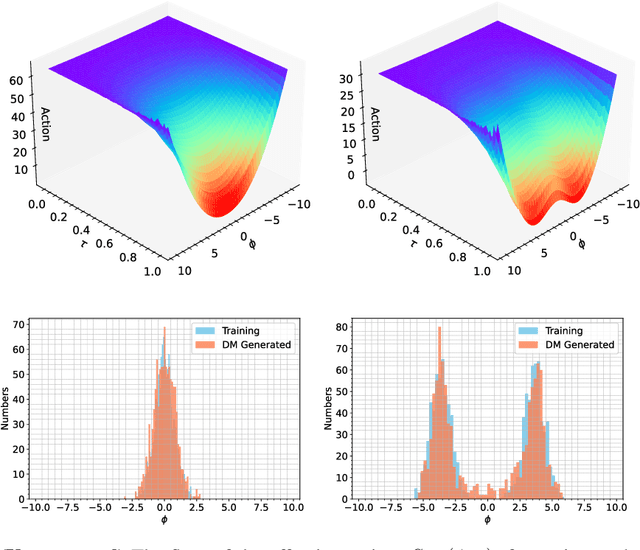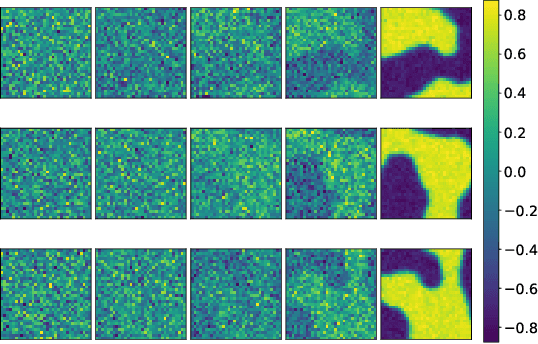Gert Aarts
Swansea University
Strategic White Paper on AI Infrastructure for Particle, Nuclear, and Astroparticle Physics: Insights from JENA and EuCAIF
Mar 18, 2025Abstract:Artificial intelligence (AI) is transforming scientific research, with deep learning methods playing a central role in data analysis, simulations, and signal detection across particle, nuclear, and astroparticle physics. Within the JENA communities-ECFA, NuPECC, and APPEC-and as part of the EuCAIF initiative, AI integration is advancing steadily. However, broader adoption remains constrained by challenges such as limited computational resources, a lack of expertise, and difficulties in transitioning from research and development (R&D) to production. This white paper provides a strategic roadmap, informed by a community survey, to address these barriers. It outlines critical infrastructure requirements, prioritizes training initiatives, and proposes funding strategies to scale AI capabilities across fundamental physics over the next five years.
Physics-Conditioned Diffusion Models for Lattice Gauge Theory
Feb 08, 2025



Abstract:We develop diffusion models for simulating lattice gauge theories, where stochastic quantization is explicitly incorporated as a physical condition for sampling. We demonstrate the applicability of this novel sampler to U(1) gauge theory in two spacetime dimensions and find that a model trained at a small inverse coupling constant can be extrapolated to larger inverse coupling regions without encountering the topological freezing problem. Additionally, the trained model can be employed to sample configurations on different lattice sizes without requiring further training. The exactness of the generated samples is ensured by incorporating Metropolis-adjusted Langevin dynamics into the generation process. Furthermore, we demonstrate that this approach enables more efficient sampling of topological quantities compared to traditional algorithms such as Hybrid Monte Carlo and Langevin simulations.
Physics-Driven Learning for Inverse Problems in Quantum Chromodynamics
Jan 09, 2025Abstract:The integration of deep learning techniques and physics-driven designs is reforming the way we address inverse problems, in which accurate physical properties are extracted from complex data sets. This is particularly relevant for quantum chromodynamics (QCD), the theory of strong interactions, with its inherent limitations in observational data and demanding computational approaches. This perspective highlights advances and potential of physics-driven learning methods, focusing on predictions of physical quantities towards QCD physics, and drawing connections to machine learning(ML). It is shown that the fusion of ML and physics can lead to more efficient and reliable problem-solving strategies. Key ideas of ML, methodology of embedding physics priors, and generative models as inverse modelling of physical probability distributions are introduced. Specific applications cover first-principle lattice calculations, and QCD physics of hadrons, neutron stars, and heavy-ion collisions. These examples provide a structured and concise overview of how incorporating prior knowledge such as symmetry, continuity and equations into deep learning designs can address diverse inverse problems across different physical sciences.
* 14 pages, 5 figures, submitted version to Nat Rev Phys
Random Matrix Theory for Stochastic Gradient Descent
Dec 29, 2024Abstract:Investigating the dynamics of learning in machine learning algorithms is of paramount importance for understanding how and why an approach may be successful. The tools of physics and statistics provide a robust setting for such investigations. Here we apply concepts from random matrix theory to describe stochastic weight matrix dynamics, using the framework of Dyson Brownian motion. We derive the linear scaling rule between the learning rate (step size) and the batch size, and identify universal and non-universal aspects of weight matrix dynamics. We test our findings in the (near-)solvable case of the Gaussian Restricted Boltzmann Machine and in a linear one-hidden-layer neural network.
Diffusion models learn distributions generated by complex Langevin dynamics
Dec 02, 2024



Abstract:The probability distribution effectively sampled by a complex Langevin process for theories with a sign problem is not known a priori and notoriously hard to understand. Diffusion models, a class of generative AI, can learn distributions from data. In this contribution, we explore the ability of diffusion models to learn the distributions created by a complex Langevin process.
Dyson Brownian motion and random matrix dynamics of weight matrices during learning
Nov 20, 2024Abstract:During training, weight matrices in machine learning architectures are updated using stochastic gradient descent or variations thereof. In this contribution we employ concepts of random matrix theory to analyse the resulting stochastic matrix dynamics. We first demonstrate that the dynamics can generically be described using Dyson Brownian motion, leading to e.g. eigenvalue repulsion. The level of stochasticity is shown to depend on the ratio of the learning rate and the mini-batch size, explaining the empirically observed linear scaling rule. We verify this linear scaling in the restricted Boltzmann machine. Subsequently we study weight matrix dynamics in transformers (a nano-GPT), following the evolution from a Marchenko-Pastur distribution for eigenvalues at initialisation to a combination with additional structure at the end of learning.
On learning higher-order cumulants in diffusion models
Oct 28, 2024



Abstract:To analyse how diffusion models learn correlations beyond Gaussian ones, we study the behaviour of higher-order cumulants, or connected n-point functions, under both the forward and backward process. We derive explicit expressions for the moment- and cumulant-generating functionals, in terms of the distribution of the initial data and properties of forward process. It is shown analytically that during the forward process higher-order cumulants are conserved in models without a drift, such as the variance-expanding scheme, and that therefore the endpoint of the forward process maintains nontrivial correlations. We demonstrate that since these correlations are encoded in the score function, higher-order cumulants are learnt in the backward process, also when starting from a normal prior. We confirm our analytical results in an exactly solvable toy model with nonzero cumulants and in scalar lattice field theory.
Stochastic weight matrix dynamics during learning and Dyson Brownian motion
Jul 23, 2024Abstract:We demonstrate that the update of weight matrices in learning algorithms can be described in the framework of Dyson Brownian motion, thereby inheriting many features of random matrix theory. We relate the level of stochasticity to the ratio of the learning rate and the mini-batch size, providing more robust evidence to a previously conjectured scaling relationship. We discuss universal and non-universal features in the resulting Coulomb gas distribution and identify the Wigner surmise and Wigner semicircle explicitly in a teacher-student model and in the (near-)solvable case of the Gaussian restricted Boltzmann machine.
Generative Diffusion Models for Lattice Field Theory
Nov 06, 2023


Abstract:This study delves into the connection between machine learning and lattice field theory by linking generative diffusion models (DMs) with stochastic quantization, from a stochastic differential equation perspective. We show that DMs can be conceptualized by reversing a stochastic process driven by the Langevin equation, which then produces samples from an initial distribution to approximate the target distribution. In a toy model, we highlight the capability of DMs to learn effective actions. Furthermore, we demonstrate its feasibility to act as a global sampler for generating configurations in the two-dimensional $\phi^4$ quantum lattice field theory.
Diffusion Models as Stochastic Quantization in Lattice Field Theory
Sep 29, 2023Abstract:In this work, we establish a direct connection between generative diffusion models (DMs) and stochastic quantization (SQ). The DM is realized by approximating the reversal of a stochastic process dictated by the Langevin equation, generating samples from a prior distribution to effectively mimic the target distribution. Using numerical simulations, we demonstrate that the DM can serve as a global sampler for generating quantum lattice field configurations in two-dimensional $\phi^4$ theory. We demonstrate that DMs can notably reduce autocorrelation times in the Markov chain, especially in the critical region where standard Markov Chain Monte-Carlo (MCMC) algorithms experience critical slowing down. The findings can potentially inspire further advancements in lattice field theory simulations, in particular in cases where it is expensive to generate large ensembles.
 Add to Chrome
Add to Chrome Add to Firefox
Add to Firefox Add to Edge
Add to Edge